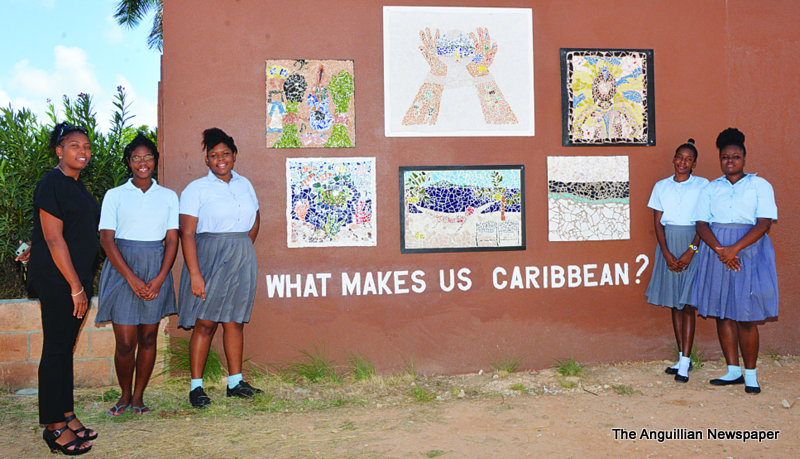
During the COVID-19 lockdown when students were restricted at home, Sixth Form students of the Albena Lake Hodge Comprehensive School (ALHCS) were encouraged by their Visual Arts teacher, Mrs. Navene Mairyshaw, engage in an art project of designing and creating a mosaic suitable for installation at a local school. The theme of the creation is pertinent to the question “What Makes You Caribbean?”.
Students responded in different ways as they examined various aspects of Caribbean life and determined what these life styles meant to them. A total of six students from Forms 6A & 6B participated in the project. They came up with six separate works of art depicting ways of life in the Caribbean, and the imagery has been mounted at Campus B.
Students involved in the art project were Renee Carter, Delzinnia Connor, Julissa Richardson, Selvio Hodge, Delnicia Carty and Facianne Stevens.
The Anguillian spoke with both the teacher and the students about the project. According to Mrs. Mairyshaw, “before the COVID-19 lock down, the students were tasked to create a mosaic based on the concept of what makes us Caribbean. They were supposed to interpret that concept however they felt about it personally and socially. They began to collect the material from which they would form their creations. Items such as old ceramic plates, tiles and glass bottles were gathered as resources, and the idea was to do the work in class as a regular Art class project.
“Then COVID-19 hit, and the students decided to do the work independently from home. They had a little feedback from me via Edmodo, but for the most part they worked on their own. When school reopened, they brought their work in. Some of them had a little bit of editing to make, but generally they were fine, and I was extremely impressed with the creations.”
The students sought to explain the significance of each individual piece of art. First, Facianne Stevens commented on her design, which is the one at the top left: “My piece is basically about Caribbean history which encompasses slavery and music. It features a black fist in the centre which represents ‘black power’. As we know, there is a crisis going on in the U.S. and the world now in which justice and peace for blacks are being threatened, and the slogan ‘Black Lives Matter” is dominant.”
In pointing to the guitar, Faciane continued: “I decided to include the guitar because the Caribbean features various genre of music such as soca, calypso, reggae and dancehall. Besides, during the slave trade in the Caribbean, masters used music played by slaves as a means of welcoming other slaves to their plantations.”
Next, was Julissa Richardson’s piece (which is at the bottom left). She explained: “When I first thought about the assignment the first thing I did was to answer the question what makes us Caribbean? To me the sea forms the basis of our lives as Caribbean people. Tourism, which is our main industry, is linked to our healthy and thriving marine life. And that was the concept that I depicted.”
Renee Carter then showed off her piece, (the one at the centre bottom). She explained: “Basically, I wanted to represent the relaxing environment of the Caribbean. Whereas others may find it more common to think about carnival, I chose to focus on the more tranquil aspect of Caribbean life. So, I chose the beach because to me the beach is my safe place, and there is where I feel most creative. I have elements as the steel pan and the coconut tree, and black woman is shown laying in a hammock with the head tied, symbolic of our old Caribbean culture.”
The fourth display was that of Delzinnia Connor (whose work is the largest at the centre top). She said: “This encompasses many aspects of Caribbean life.” “In the globe it depicts a beach since the Caribbean is well known for its beaches. The two hands that hold the globe also hold a broken chain that represents our freedom from slavery. In the right hand there is a masquerade that stands for the Caribbean’s vibrant, colorful life. And then on the left hand bears the symbol of music that was used as a form of communication during slavery.”
Next was the work of Delnicia Carty (at the top right). Hers showed a carnival masquerade depicting the carnival aspect of the Caribbean. The image is that of a female form sporting a feathery costume.
The final work was a piece created by the only male student, Selvio Hodge. His is mounted at the bottom right. It depicts the Caribbean Sea. It shows shells in the ocean depths in a distance, and as you move the deep blue waters become lighter towards the shoreline until one reaches the white sandy beach.
In her closing comments on the art, the teacher, Mrs. Mairyshaw, remarked: “Throughout the whole process, the students were able to learn how to work independently on their own pieces. This is something that they never did before. Going forward, they can use the experience of using found materials to mentally verbalize a project, create something beautiful and then bring it all together as a group with work that complements each others’.”
- Staff Reporter, James R. Harrigan







